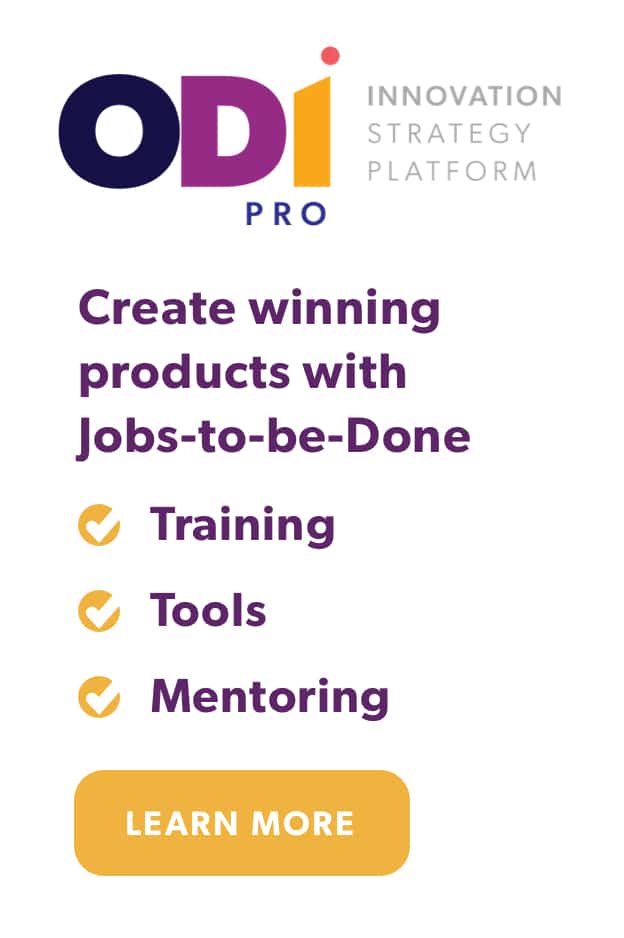I recently came across yet another innovation promo video from a leading multinational manufacturer.
You know the one: very professionally produced, with a slick mix of the obligatory out-of-focus, slow-motion, zoomed-in camera shots. A group of young, attractive “creatives” in scarves, manicured beards, and brightly colored glasses, in the throes of a high-energy brainstorming session.
“IDEAS” is prominently drawn in block letters on the wall, surrounded by a web of lines, arrows, more scribbles, words, and a lot of question marks. The floor is covered with crumpled up sticky notes, while the narrator speaks passionately of collaboration, musical improvisation, and creative “flow.”
I hate to break it to this company and others like them, but that’s NOT innovation.
The Brainstorming Myth
Brainstorming sessions like this one are a classic example of feel-good innovation. Everyone knows the first rule of brainstorming: there are no bad ideas.
Well, anyone who’s ever actually tried to turn ideas into reality knows that’s hogwash. There are BILLIONS of bad ideas. In fact, MOST ideas are bad, and some are GALACTICALLY bad.
There’s thinking outside the box, and then there’s thinking there IS no box. There is ALWAYS a box, and often the answer is tucked away down in the corner because everybody’s too busy exploring the exterior.
Managers often emerge from a marathon brainstorming session feeling exhausted but energized and uber optimistic. Like they’ve just solved all the world’s problems. That was a blast! Did you see all those sticky notes on the walls? they excitedly ask their team members on their way back to their offices. We were really pushing the envelope and pumping out the ideas! We must have 850 ideas now! This is gonna be great!
Then they wake up the next morning and start reviewing the notes from the session. And it hits them like a brainstorm hangover:
Oh NO. We’ve got over 800 ideas here! How are we gonna figure out where to start? Wha—How did THAT end up on the list?? I knew I shouldn’t have invited Jerry from Logistics… Just vetting even a FRACTION of these ideas is going to take months and blow my entire project budget! What have I DONE!?
Whether or not the brainstorm hangover hits, they dive into their list, desperately prioritizing the ideas based on whatever criteria they can come up with—the title of the person who suggested them, how “innovative” they seem, which of them the competition has, how many sales reps have begged for them, how easy they sound to develop…
They then set their team to work feverishly building financial models, sizing markets, estimating ROIs, mocking up prototypes and showing them to glaze-eyed focus groups. Millions of dollars and months or years later, they finally launch what they desperately hope will be the Next Big Thing and cross their fingers.
And 80% of the time, it flops.
And then they start the whole process over again. After all, they tell themselves, that’s how the innovation game goes: you pays your money, and you takes your chances.
Nearly everything we do in business—from accounting to manufacturing to sales to you name it—is expected to be done with precision, to be driven by data and rigorous process, and to result in solid, measurable results and consistently attractive returns on investment of time, money and risk. Except innovation.
We’ve come to equate innovation with creativity, and as such, it seems we’ve granted innovation a kind of celebrity status among business functions. We establish innovation as a core value, and we give it its own special section on the org chart, while paradoxically declaring it “everyone’s job.” We hire people who don’t like boundaries, and we set them apart from the rest of the organization, with a separate reporting structure and sometimes even their own little “innovation lab,” so they won’t be disturbed, judged, distracted or uninspired by the drones. And then, worst of all, we accept wildly inconsistent results from their efforts.
Creativity Is Not Innovation
If innovation is “the process of devising solutions that address unmet customer needs,” then creativity has very little to do with it. (And if you have a significantly different definition of innovation, maybe that’s your problem right there. You’re welcome.) In other words, the whole point of innovation is to provide something that the customer needs but is not getting now. That requires understanding the following, exactly, consistently, and in great detail:
- Who the customer is
- What they’re trying to get done
- What their needs are when they’re trying to get it done
- Which of those needs are not being met
Trick question: Which of the above pieces of information can be gleaned from even the most creative internal ideation session? I’ll wait…
Creatives, cover your ears (or your eyes)…innovation can and should be reliable and predictable (i.e., “boring”).
Yep. Believe it or not, the business equivalent of a blindfolded dart game is NOT the most effective way to ensure your organization’s long-term survival. Your innovation efforts, the lifeblood of any competitive business, deserve the same standard of performance as any other investment.
By what black magic is this miracle accomplished? you may ask. It’s the opposite of magic, actually. If you want to evolve your innovation from a crapshoot to predictable success, you need to use a predictable process. Which means you need to turn your innovation into—GASP—a SCIENCE.
The Engineer’s Way Saves the Day
Say what you want about engineers (and most people do), but when it comes to designing “boring” processes, they’re the champs. When manufacturing needed to become more reliable and consistent (less variation, more boredom), engineers came up with Six Sigma. It worked like a charm. Manufacturing, though now painfully tedious in its repetitiveness, provides absolutely thrilling quality, predictability, and profitability. It’s a thing of beauty. And now we’ve taken that philosophy and applied its benefits to practically everything else we do. Except innovation.
Until now.
Actually, until about 27 years ago, when a young IBM Design Engineer, still smarting from the PCjr’s billion-dollar failure, decided to try applying Six Sigma principles to the innovation process, because hey, it couldn’t get any worse, right?
Well, it got better. A LOT better.
That young engineer was Tony Ulwick, founder of Strategyn. The Strategyn team designed a scientific, data-driven, low-variability, creativity-free process of agreeing on, gathering, understanding and addressing unmet customer needs. Cordis Corporation, a medical device manufacturer, was the very first company to apply this process, known as Outcome-Driven Innovation (ODI), in 1992. As a result of ODI, Cordis launched 19 products within two years, all of which became #1 or #2 in the market, increasing Cordis’ market share by 20x and its stock price by 400%.
First pitch, out of the park.
Over 1,000 innovation projects later, ODI has been proven to yield an eye-popping 86% success rate among companies who have followed it.
Now, thrill seekers and adrenaline junkies addicted to the high-risk, high-stakes game of traditional innovation may look at this approach and yawn. Where’s the fun in knowing BEFORE you launch a product or service that it’s very likely to be a hit? You may be right. On the other hand, beating the house legally over and over again might prove to be even more addicting than waiting for the occasional jackpot to wipe out all your losses.
Just because innovation is about envisioning what doesn’t currently exist doesn’t mean it can’t or shouldn’t be just as disciplined and predictable as any other business function. Innovation is like any entrepreneurial venture—if you want it to produce like a real business, you need to treat it like a real business, complete with process, rules, metrics, data and performance standards. If you treat it like a creative hobby, it might be fun alright, but fun doesn’t pay the bills.



